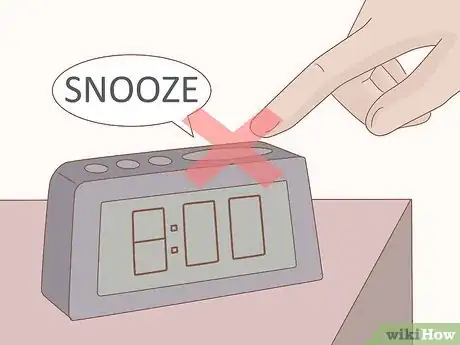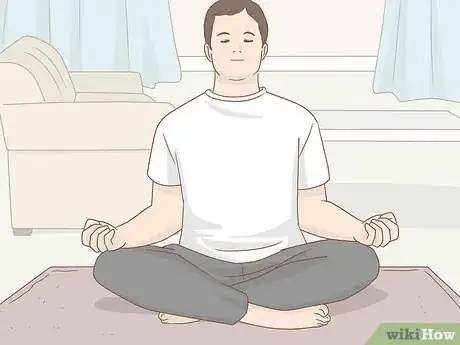This article was co-authored by Kirsten Parker, MFA. Kirsten Parker is a Mindset and Action Coach based in her hometown of Los Angeles, California. She helps high achievers overcome stress and self-doubt. She specializes in increasing one's confidence and clarity by incorporating tools from positive psychology, mindful habit change, and self-regulation into her coaching. She is a Certified HeartMath Practitioner trained in Stress, Anxiety, and Intelligent Energy Management along with Emotional Intelligence and the Science of Self-Acceptance. She also holds an MFA from Yale University School of Drama in Stage Management.
There are 26 references cited in this article, which can be found at the bottom of the page.
This article has been viewed 215,619 times.
Living a calm life can be a challenge in modern society. Crowded cities, increasingly interconnected technology, and the pressures of work and daily life may seem to conspire against a serene existence. Peace, however, is easier to find than you might imagine.
Steps
Creating a Calm Environment
-
1Arrange your home to facilitate calmness. There are many things you can do to make your home a place of tranquility, even if you have a busy family life. Use interior design and organization to your advantage and give yourself a little breathing space at home.
- Organize your entryway to reduce clutter. Being greeted with a mess as soon as you walk in the door is a recipe for stress. Give your shoes, umbrellas, and other everyday items a dedicated place near the door. They'll be out of sight, and out of mind.
- Dedicate a space for clutter, and try to confine it there. Keeping an entire house neat and tidy all the time is impractical, especially when children are involved. Instead, dedicate just one or two areas where everyone can drop their bags, pile up the mail, and so on.
- Add a little music. Classical music, or other instrumental styles like jazz, can calm nerves and soothe tempers. The music should be slow and quiet to get that calming effect.[1] Keeping a little ambient music going is a great way to keep an even keel.
- Pamper your bedroom. You will spend up to a third of your life in bed: make sure your bedroom is a place of refuge. It's the last place you see in the evening, and the first you encounter in the morning. Use comfortable bedding, with soft, high-thread count sheets to give yourself a good night's rest, and consider a wake-up light as an alternative to a conventional alarm clock for a smoother start to your day.[2]
-
2Build a calm workspace. You'll probably spend a good portion of your waking hours at work, so it's wise to build a soothing space there where possible. Workplaces vary widely, from offices to the outdoors, so tailor changes to suit your individual needs.
- Reduce clutter and clear your work area of unnecessary items. This can help reduce distractions and keep you focused on the task at hand.
- Keep it clean. Get rid of trash, stains, spots, and smells to reduce potential sources of displeasure. Just as with clutter, this will be an ongoing battle, so don't let the cleaning itself become a distraction or source of stress. Regular maintenance is the key.
- Post pictures of pleasant things. Photographs of your family, or of calming scenes, or places you'd like to visit can enhance your workday with reminders of what's good in life and why you're at work in the first place.
- If you have your own office, shut the door. It will discourage visitors, keep out noise, and give you a sense of privacy and perhaps even isolation. If your job requires frequent collaboration with others, pick out brief periods of the day for some closed-door time before reopening to the world.
Advertisement -
3Take advantage of color and light. Certain arrangement of color and lighting can have dramatic effects on your mood and productivity.[3] Adjusting the shade, tone, and intensity of the decor around you is an under-appreciated way to maintain a peaceful environment.
- Choose muted colors over bright ones. Bright tones can lead to anxiety, so softer shades are a better choice. Relatedly, use matte (non-reflective) rather than glossy tones to reduce reflections and distractions.[4]
- Blues and lavenders are preferable for bedrooms and areas that should be calm and tranquil.[5]
- Use recessed lighting and floor or desk lamps to create a sense of closeness. This also reduces the harsh light from bare, direct light bulbs. Install warm-white bulbs (check the packaging when you buy) to keep the tone soft. Bright-white bulbs can give off an industrial vibe and are harsh to look at.
-
4Get away from it all. Spend time out in nature to calm yourself and recharge. Anything from a quick walk in the park, to an extended trek in the wilderness can be calming and restorative, especially if you spend most of your time in urban environments.
- Take it slow. Get out in the outdoors, and take the time to soak in your surroundings. Watch clouds for a bit, or perhaps kick off your shoes and enjoy the feeling of grass between your toes.
- Do a little photography while you're out. If you come across a landscape that inspires you, capture the moment so you can come back to it later for a bit of restoration.
- Engage with nature. If you're so inclined, take up a hobby that requires active involvement with nature. Fly fishing, for example, requires both peaceful, relaxing motion and the willingness to understand the mechanics of rivers, lakes, and many forms of aquatic life. Rock climbing can take you to breathtaking views and some personal knowledge of geology. In any case, feeling closer to the natural world is a great way to de-stress and build a calm space in your life.[6]
Calming Yourself
-
1Establish a morning ritual. A great way to reduce stress and turbulence is to develop reliable, repeatable systems for your everyday life that keep you centered and reduce stress. If your days get off to a frantic start, make a conscious effort to slow things down in the morning.[7]
- Get up a little earlier, make coffee, and include calming activities like yoga, meditation, or something else that you find relaxing. Make it a part of your day, every day.[8]
- Identify what you would like to accomplish each morning, then customize your ritual to give you the time to do those things without rushing or added stress.[9]
- Take charge of your time and energy.[10] When you have a busy schedule, it's easy to feel like you have no control over what you do. Try imagining everything you do is a choice, even things that seem totally necessary, like going to work or taking your kids to school. This will help you feel like you have control over how you spend your day. It can also empower you to take more time out of your day to rest and care for your body and mind.[11]
-
2Be mindful of how you react to things. If you frequently find yourself getting worked up during everyday interactions, make it a habit to analyze your own responses.
- If someone cuts you off in traffic, pause a moment instead of laying on the horn and consider if your response will help the situation, or merely add to your stress.
-
3Don't multitask. Study after study shows that multitasking is a less-efficient way of getting things done than focusing on a single activity, and constantly diverting your attention between multiple things is a surefire way to maintain anxiety rather than calm.[12]
- Simple changes like leaving your phone in another room, or turning off email notifications can remove common temptations for distraction.[13]
- Having a prioritized to-do list helps. Focus on completing your most important task before moving on to others. Keep in mind that recreation, exercise, or family time can be a “task” — this isn't only about work.[14]
-
4Get regular exercise. Not only is it good for your health, it is also shown to reliably reduce stress levels.[15]
- If you can integrate exercise into your routine, do so. Even 20 minutes of moderate exertion can do wonders for you.
- You don't have find time for the gym to get the benefits of exercise. Get out of your desk chair and take a walk. Take the stairs rather than the elevator.
- Integrate soothing music or pleasant imagery into your post-exercise cool down. It will help maintain a sense of serenity as you get back to what you were doing.[16]
-
5Get creative. Creative activity, especially when you can work with your hands, is a fantastic way to keep your thoughts and days tranquil. You can lose yourself in your task, and gain a sense of accomplishment along the way.[17]
- Woodworking, pottery, and knitting are great ways to engage your hands and mind in a focused, calming manner.
- Others find similar solace in art, be it painting, sculpture, or even writing.
- The kitchen can also be a place for creative handiwork. Baking, cooking, and even more specialized tasks like brewing can be great outlets for stress and creativity.[18]
-
6Try yoga or meditation. The health benefits of both yoga and meditation are numerous and well-documented. Both endeavor to give you peace of mind and reduce stress, and yoga can also enhance your strength and flexibility.[19] [20]
- Yoga engages your parasympathetic nervous system, prompting a “relaxation effect.”[21]
- Both yoga and meditation have the added benefit of being relatively simple to do just about anywhere. Try a few simple poses in a free moment at work, or in your bedroom just after your rise in the morning to help smooth out your day.[22]
-
7Interrupt the fight-or-flight response.[23] Your body's instinctive reaction to stress and danger, the “fight-or-flight” response, is a fine evolutionary adaptation, but one not always well-suited to a calm, modern life, free from the dangers of wild animals and hostile hunter-gatherers. Luckily, there are ways to mitigate this occasionally unwanted reaction.
- Reflect on your feelings. This sounds cliche, but the simple act of identifying feelings of panic, stress, fear, or anxiety can interrupt the neurological processes of fight-or-flight and help you redirect your energy usefully.[24]
- Focus on your breathing.[25] When you find tension or even panic rising, focus on taking deep breaths. This cuts down on the instinctive tendency toward shallow, quick breaths and engages your autonomic nervous system, which usually controls your body's physiological responses without your conscious input.[26]
- Finally, re-label the feelings you identified previously to make them more positive. Recast your panic as excitement, or your frustration as ambition and you can regain control of your body's stress response, lowering your heartbeat, respiration, and sweating.
Calming Others Around You
-
1Learn how to calm someone who's upset. Inevitably, someone around you, be it a friend, co-worker, or family member, is going to get upset, and this is likely to disrupt things for everyone around them.
- Use the E.A.R. method to settle the situation.[27]
- Empathy — Show the other person that you understand he is upset with statements like, “I can see how upset you are,” or “I understand that you are feeling frustrated,” and indicate your willingness to help him.
- Attention — Ask him to explain the problem and listen attentively. “Tell me what's bothering you. I want to understand.” Body language can help you here as well. Make eye contact with him and sit or lean forward slightly to show your attentiveness.
- Respect — People, especially those prone to conflict, often need to feel respected when they're upset. Acknowledge this as best you can with statements like: “I respect your commitment to this,” or, “I can tell you've put in a great deal of effort here and it shows.” [28]
-
2Defuse an angry situation before it escalates. Someone who is very angry may not be receptive to discussion until she has had a chance to cool down. You can help this process along by redirecting her anger and acting appropriately to reduce the level of tension.
- First, try to communicate respect for her needs or concerns. Acknowledge their importance, and refrain from openly judging them. Try to do this with non-aggressive body language by not moving quickly or taking an aggressive, chest-out posture.
- Cooperate with the angry person, so long as it does not cause harm to others. The objective is to not escalate the situation any further. Effective listening will help here too. Don't interrupt her, but take the opportunity to ask clarifying questions, both to avoid misunderstanding and to slow things down.
- Redirect her aggression by rephrasing her concerns in a less confrontational manner. Restate, “I want to beat Janet with a pipe,” as, “So, you are upset with Janet for scratching the paint on your car and want her to make it right.” This, when successful, can leave the person calmer and more open to a constructive discussion of her problem.
- Disengage yourself from the interaction if your efforts are not working or you find yourself getting angry as well. Your safety is paramount, and you should get away from the person, and call security, a supervisor, or the police as appropriate.
-
3Use kindness and humility. Research shows that being humble and kind to others can materially improve your relationships at home, at work, and socially. Being good to others, it turns out, can be good for you as well.
- Being kind to others can make you physically and mentally healthier, an NIH study has found.[29]
- Humility — a willingness to self-critique — can also help repair damaged relationships.[30]
- Kindness is also linked to happiness. Acts of charity and kindness release dopamine and endorphins in your brain, giving a chemical element to your happiness.[31]
Expert Q&A
-
QuestionHow can I live a stress-free life?
 Kirsten Parker, MFAKirsten Parker is a Mindset and Action Coach based in her hometown of Los Angeles, California. She helps high achievers overcome stress and self-doubt. She specializes in increasing one's confidence and clarity by incorporating tools from positive psychology, mindful habit change, and self-regulation into her coaching. She is a Certified HeartMath Practitioner trained in Stress, Anxiety, and Intelligent Energy Management along with Emotional Intelligence and the Science of Self-Acceptance. She also holds an MFA from Yale University School of Drama in Stage Management.
Kirsten Parker, MFAKirsten Parker is a Mindset and Action Coach based in her hometown of Los Angeles, California. She helps high achievers overcome stress and self-doubt. She specializes in increasing one's confidence and clarity by incorporating tools from positive psychology, mindful habit change, and self-regulation into her coaching. She is a Certified HeartMath Practitioner trained in Stress, Anxiety, and Intelligent Energy Management along with Emotional Intelligence and the Science of Self-Acceptance. She also holds an MFA from Yale University School of Drama in Stage Management.
Mindset & Action Coach One reason so many people feel stressed out is that they don't feel in control of their time and energy. If you think of your responsibilities as choices rather than obligations, you'll start to feel like you have more control over how you spend your day. This will also give you the incentive to set aside time to care for your mind and body.
One reason so many people feel stressed out is that they don't feel in control of their time and energy. If you think of your responsibilities as choices rather than obligations, you'll start to feel like you have more control over how you spend your day. This will also give you the incentive to set aside time to care for your mind and body. -
QuestionHow can I regain my calm?
 Kirsten Parker, MFAKirsten Parker is a Mindset and Action Coach based in her hometown of Los Angeles, California. She helps high achievers overcome stress and self-doubt. She specializes in increasing one's confidence and clarity by incorporating tools from positive psychology, mindful habit change, and self-regulation into her coaching. She is a Certified HeartMath Practitioner trained in Stress, Anxiety, and Intelligent Energy Management along with Emotional Intelligence and the Science of Self-Acceptance. She also holds an MFA from Yale University School of Drama in Stage Management.
Kirsten Parker, MFAKirsten Parker is a Mindset and Action Coach based in her hometown of Los Angeles, California. She helps high achievers overcome stress and self-doubt. She specializes in increasing one's confidence and clarity by incorporating tools from positive psychology, mindful habit change, and self-regulation into her coaching. She is a Certified HeartMath Practitioner trained in Stress, Anxiety, and Intelligent Energy Management along with Emotional Intelligence and the Science of Self-Acceptance. She also holds an MFA from Yale University School of Drama in Stage Management.
Mindset & Action Coach Try focusing on your breathing. This can calm down your fight-or-flight response.
Try focusing on your breathing. This can calm down your fight-or-flight response.
References
- ↑ http://psychcentral.com/lib/the-power-of-music-to-reduce-stress/
- ↑ http://www.goodhousekeeping.com/home/organizing/tips/a20531/create-a-peaceful-home/
- ↑ http://www.nytimes.com/1982/10/19/science/color-has-a-powerful-effect-on-behavior-researchers-assert.html?pagewanted=all
- ↑ http://blog.desktime.com/2013/08/15/calm-and-focused-how-lighting-and-color-affect-productivity/
- ↑ http://www.webmd.com/women/home-health-and-safety-9/color-psychology?page=2
- ↑ http://tinybuddha.com/blog/5-ways-to-find-happiness-in-nature/
- ↑ http://www.care2.com/greenliving/reduce-stress-with-a-calming-morning-ritual.html
- ↑ http://www.care2.com/greenliving/reduce-stress-with-a-calming-morning-ritual.html
- ↑ http://www.lifehack.org/articles/featured/morning-ritual.html
- ↑ Kirsten Parker, MFA. Mindset & Action Coach. Expert Interview. 22 July 2020.
- ↑ Kirsten Parker, MFA. Mindset & Action Coach. Expert Interview. 22 July 2020.
- ↑ http://www.apa.org/monitor/oct01/multitask.aspx
- ↑ http://zenhabits.net/calm/
- ↑ http://zenhabits.net/how-not-to-multitask-work-simpler-and/
- ↑ http://www.adaa.org/understanding-anxiety/related-illnesses/other-related-conditions/stress/physical-activity-reduces-st
- ↑ http://www.health.com/health/gallery/0,,20425626_4,00.html
- ↑ https://www.psychologytoday.com/blog/the-creativity-cure/201402/how-be-calm-person
- ↑ https://www.psychologytoday.com/blog/the-creativity-cure/201402/how-be-calm-person
- ↑ http://www.health.harvard.edu/staying-healthy/yoga-benefits-beyond-the-mat
- ↑ http://www.mayoclinic.org/tests-procedures/meditation/in-depth/meditation/art-20045858
- ↑ http://www.yogajournal.com/article/teach/the-scientific-basis-of-yoga-therapy/
- ↑ http://www.yogajournal.com/article/health/count-yoga-38-ways-yoga-keeps-fit/
- ↑ Kirsten Parker, MFA. Mindset & Action Coach. Expert Interview. 22 July 2020.
- ↑ http://thescienceexplorer.com/brain-and-body/neuroscience-tips-remain-calm-under-pressure
- ↑ Kirsten Parker, MFA. Mindset & Action Coach. Expert Interview. 22 July 2020.
- ↑ http://www.lifehack.org/articles/productivity/science-has-these-10-things-keep-calm-under-pressure.html
- ↑ http://www.mediate.com/articles/EddyB8.cfm
- ↑ https://www.highconflictinstitute.com/free-articles/2018/3/11/calming-upset-people-with-ear
- ↑ http://lifehacker.com/how-being-humble-kind-and-calm-will-make-your-life-ea-1561763720
- ↑ http://www.spring.org.uk/2014/04/8-practical-ways-being-humble-improves-your-life.php
- ↑ http://www.independent.co.uk/life-style/health-and-families/healthy-living/cool-to-be-kind-the-advantages-of-being-altruistic-6259543.html







-Step-7.webp)



-Step-3.webp)






























































